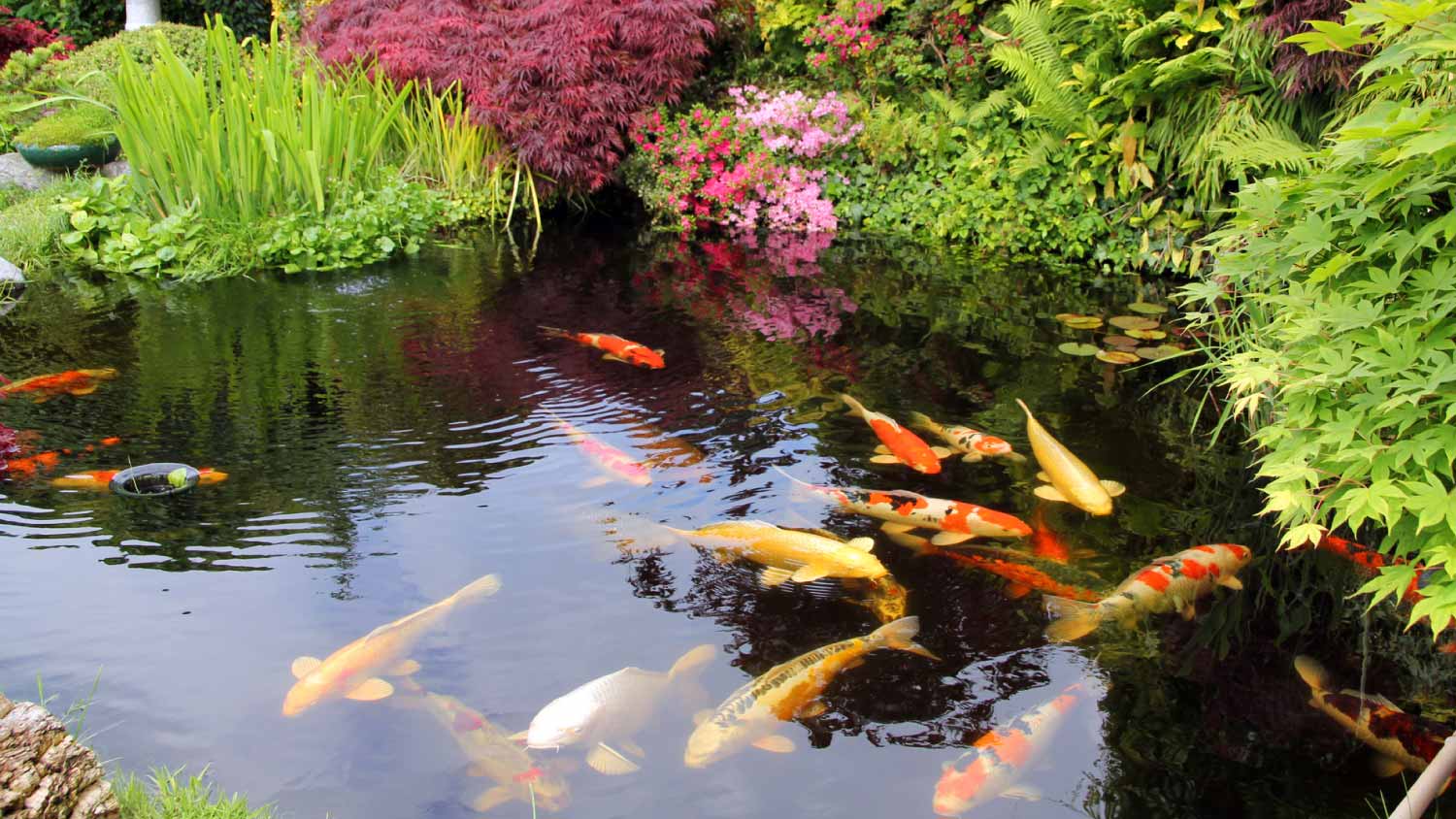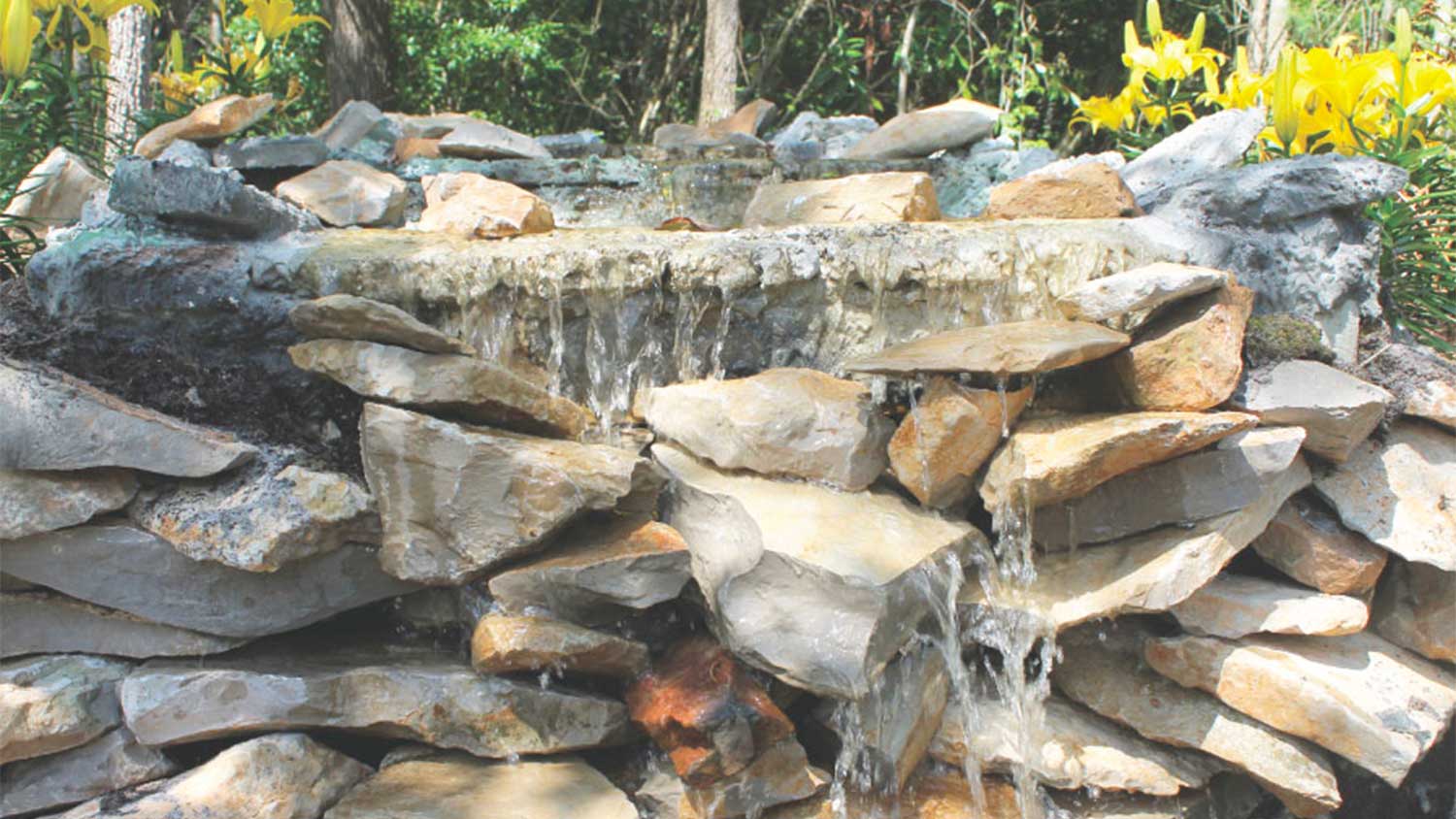Standard Koi Pond Sizes: What Koi Pond Size Do You Need?
No need to be coy when it comes to koi pond sizing


Koi ponds should be a minimum of 3 feet deep — standard dimensions are 8 feet by 6 feet at that depth.
You should account for between 200 and 250 gallons of water per koi fish you add to your pond.
Make sure your filtration system and aeration equipment can accommodate your koi pond size.
If you’re planning on installing a koi pond in your yard or even just want to stock the one you already have, understanding the importance of koi pond size is crucial. Getting it right means getting maximum enjoyment from your new landscaping feature, while getting it wrong can mean hundreds or thousands of dollars wasted and doing a disservice to the fish you place in your pond. In this guide, we’ll discuss koi pond size and what’s ideal for your yard to help you get it right.
What Is the Standard Koi Pond Size?
The standard koi pond is about 8 feet long by 6 feet wide with a depth of 3 feet. That size pond would hold roughly 1,000 gallons, which is suitable for stocking up to four koi fish. Koi pond size can vary widely in all dimensions as well as by volume.

Koi Pond Size by Number of Fish

If you know roughly the size of the fish population you want in your pond, you can use that number to figure out what koi pond size you need. Generally speaking, you should aim for around 250 gallons per koi fish. This might seem like overkill at first, but once your fish reach their full size—up to 36 inches long—it’s important that they have enough space to swim freely and avoid fighting over territory or mates with the other fish.
Using the rule of thumb of maintaining 250 gallons per fish, refer to the table below to figure out the ideal volume for your pond.
| Number of Fish | Gallons Required |
|---|---|
| 1 | 250 |
| 2 | 500 |
| 4 | 1,000 |
| 5 | 1,250 |
| 10 | 2,500 |
| 15 | 3,750 |
Note that there are requirements other than volume for koi fish to be happy and healthy. These include a minimum of 3 feet of depth to help regulate body temperature, avoid overcrowding, and stay protected from predators, as well as proper filtration and aeration.
Koi Pond Size for Up to 5 Fish
If you know you want five koi fish in your pond, aim for 1,250 gallons, which gives each fish 250 gallons of space. You can, of course, put fewer fish in a pond this size, but avoid adding more, as this will lead to overcrowding. It’s a good idea to put just a single male and four females in a pond this size to prevent fighting over territory and mates.
Standard dimensions for a 1,250-gallon koi pond at the recommended 3-foot depth are as follows:
8 ft. by 7 ft.
9 ft. by 6 ft.
12 ft. by 4 ft.
Circular pond with a diameter of 8.5 ft.
Koi Pond Size for 5 to 10 Fish
Go for a pond that’s around 2,500 gallons if you want a fish population of up to 10. Standard dimensions for this size at 3 feet deep are as follows:
8 ft. by 14 ft.
10.5 ft. by 10.5 ft.
15 ft. by 7.5 ft.
Circular pond with a diameter of 12 ft.
For a pond this size, it’s usually safe to include up to two males, with the remaining fish all being females.
Koi Pond Size for 10 to 15 Fish
For a koi pond that can comfortably house up to 15 koi fish, you should aim for a volume of 3,750 feet. Typical koi pond dimensions at this volume and at 3 feet deep are as follows:
20 ft. by 8 ft.
24 ft. by 7 ft.
30 ft. by 6 ft.
Circular pond with a diameter of 14.5 ft.
For larger ponds, you can also choose to make them deeper at 4 feet. In that case, the typical dimensions would be as follows:
12 feet by 10.5 feet
18 feet by 7 feet
20 feet by 6.5 feet
Circular pond with a diameter of 12.5 feet
At this size, you can include between two and three male koi fish, provided the rest are females.
How to Calculate Koi Pond Size
There are a few ways to calculate koi pond size, depending on your situation.
Calculating Koi Pond Size for a New Pond
If you’re installing a new pond, the easiest way to determine the dimensions you need would be to measure the space you want your pond to sit. If it’s a rectangular pond, measure both the length and width. If it’s a circular pond, measure the diameter.
Once you have the measurements, you can use the following formulas to determine your volume in gallons:
For rectangular ponds: Length (ft.) x width (ft.) x depth (ft.) = cu ft. x 7.48 = gallons in your pond
For circular ponds: Diameter / 2 = radius x radius x 3.14 = cu ft. x 7.48 = gallons
If you’re working with a local koi pond service, tell them your expectations and koi pond ideas in terms of aesthetic, size, and fish population, and they’ll help design a pond that meets your specifications and then provide you with exact dimensions and volume. Relying on an expert is especially helpful if your pond will have varying depths, as most do.
Calculating Koi Pond Size for an Existing Pond
If you already have a pond installed and need to estimate the volume to figure out filtration, aeration, and fish stocking guidelines, you have a few options for determining the volume.
First, you could measure the length, width, and depth and use the formulas above to calculate. If you have an irregular shape, you might be better off determining the flow rate of your hose and then using that to get the volume. You can follow the steps below to use this method:
Time how long it takes to fill a 1-gallon or 5-gallon bucket with the hose you plan on using to fill your pond. Make sure the valve on the hose bib is all the way open before beginning to fill the bucket.
Record how long it takes to fill the bucket.
With your pond starting completely dry, place the hose inside and open the valve all the way. At the same time, start a timer.
Once the pond is full, shut off the hose and stop the timer.
Divide the time it took to fill the pond in seconds by the time it took to fill the 1-gallon bucket in seconds to get your total koi pond volume in gallons. If you used a 5-gallon bucket, divide the time it took to fill the pond by the time it took to fill the bucket, and then divide by 5 to get the pond volume in gallons.
You can also hire a professional to gauge the pond size based on salinity changes over time after adding a predetermined amount of salt to the full pond. This is challenging to do accurately and requires a salinity test kit, but a professional can do it quickly and determine the exact volume of the pond for you.
Factors That Influence Koi Pond Size

There are a few key factors that influence the dimensions of your koi pond.
Space constraints: Of course, the room you have dedicated to your pond in your yard will put a cap on your koi pond dimensions. Take accurate measurements before moving forward with your water feature ideas.
Pond depth: Since depth affects volume, it can also impact the number of fish you can safely keep in your pond. Aim for a depth of at least 3 feet, and go deeper if you want more fish without taking up more lateral space in your landscaping.
Fish population: You should account for between 200 and 250 gallons of water for each koi fish you plan on keeping to provide enough space for comfort and health. If you know how many fish you want, use the table above to get a feel for the proper dimensions.
Filter capacity: All koi ponds require proper filtration to keep the water healthy, and your filter’s capacity could limit the size of the koi pond you keep. Maintenance for koi ponds is actually easier the larger your pond is, but you should still consider what filtration and aeration you’ll use when deciding on a koi pond size.
Climate: Your climate can also be a determining factor, as extreme climates may demand deeper water to avoid freezing or to give your fish some deeper, cooler water when the outside air is hot. Adding depth decreases your topical dimensions or increases your pond volume, so plan accordingly.
What to Do If You Have the Wrong Size Koi Pond
If you have a koi pond in your yard already but it’s not the size you want based on the dimensions you prefer or the number of fish you want to keep, your best option is to speak with a local koi pond professional to see what your options are.
In some cases, you can stretch the fish population guidelines if you oversize your filtration system, and in others, you might be able to add onto your pond, depending on the type of liner you have. Otherwise, you might have to pay to remove your koi pond and start over from scratch, which will be the most expensive option.
A professional who installs ponds will be able to help you decide what the best course of action is for your situation.














